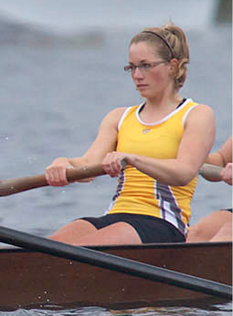The effect of your grip on the oar handle is often underestimated. The grip is critical in connecting you to the oar and the oar to the water. A good, relaxed grip will allow you to control the oar and will help you use your power effectively.

Hold the handle loosely in the palms of your hands with your fingers and thumbs wrapped around. Knuckles should be on top of the handle. Separate your hands so they are comfortable, about shoulder width apart. The outside hand should be on the end of the oar and the inside hand about three thumb lengths away. If your hands are too close together you may feel tension in your shoulders and neck and you may have difficult getting full reach at the catch.
Hand grip affects timing and control at the catch, power during the drive, and clean extraction of the blade at the finish. A tight grip creates tension in your arms, shoulders, and neck. If you are tense, your catches will be slower, you will not be able to use your legs effectively, and your attention will go directly to your arms and shoulders (try it!). A loose grip will help you to relax and will allow the handle to rotate in your outside hand during the recovery when you feather. When your hands and thumbs are relaxed, you will be better able to focus on using your legs and you should feel the muscles in your back, not your neck and shoulders.
Hand grip and feathering
Most rowers and crews like to feather the blade as a blade that is parallel to the water is easier to control during the recovery, especially in wind and rough water. Feather by turning the oar handle toward you with the inside hand only, allowing the outside hand to stay flat, the body to stay tall, and the shoulders to stay square and relaxed.